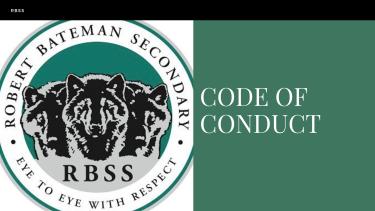
Code of Conduct
Statement of Purpose
Our motto “Eye to Eye with Respect” serves as the basis for our commitment to promoting a safe, caring and orderly school for the purpose of learning. We value diversity and strive for an environment where everyone is equal in dignity and rights and free from all forms of discrimination including gender, race, religion and sexual orientation regardless of time and place as stated in BC Human Rights Code.
Conduct Expectations
Robert Bateman students are ambassadors of the school while at school, including breaks, lunches, study blocks, travel to and from school, and while attending school functions including field trips, sporting events and dances.
Unacceptable conduct
Robert Bateman students must refrain from behaviours that undermine our goal as stated in the Statement of Purpose. Below are examples of unacceptable conduct and is not an all–inclusive list.
- Interfering with a safe, caring and orderly environment for yourself or for others
- Interfering with the learning of others
- Academic dishonesty (plagiarism and cheating)
- Ignoring rules at school related events: e.g. weapons, fireworks, drugs, alcohol, and tobacco use
- Bullying, cyber bullying, harassment, intimidation or physical violence
- Retribution against a person who has reported incidents to staff
- Publishing or displaying anything that is discriminatory against a person or a group of persons due to race, colour, ancestry, place of origin, religion, marital status, family status, physical or mental disability, sex, or sexual orientation
Consequences
Violations of the school Code of Conduct will result in consistent and fair disciplinary action. The severity, frequency, age, maturity, and any disabilities of the student will be considered in determining appropriate action. Whenever possible, disciplinary action is preventative and restorative, rather than punitive. Violations of the Student Code of Conduct will be dealt with in the following manner:
The teacher deals directly with the student(s). Most problems are minor and infrequent and can be solved/settled this way. Intervention at this level may involve a class meeting or an individual meeting with the student.
- If additional help is required to solve the problem, the following steps are employed until the problem is solved.
- The teacher contacts the parents and informs them about the problem.
- The teacher and student meet the parents. The teacher may involve the administrator in the meeting. The teacher provides the administrator with an anecdotal record of the problem and the behaviour intervention plan that has been used.
- The teacher(s), parents, student, and administrator confer regarding the behaviours necessary for the student to remain at school.
- The student is suspended from school. A conference with the student, parents, and administrator is required before the student can return to school. Some situations may warrant, or only allow for, an in-school suspension.
For a full, detailed Student Code of Conduct please consult your student handbook.